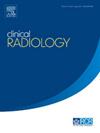New-generation 0.55T MRI in patients with total hip arthroplasty: a comparison with 1.5T MRI
IF 2.1
3区 医学
Q2 RADIOLOGY, NUCLEAR MEDICINE & MEDICAL IMAGING
引用次数: 0
Abstract
Purpose
To quantitatively and qualitatively compare the magnitude of metal total hip arthroplasty-induced imaging artifacts in vivo between 1.5T and 0.55T MRI.
Materials and Methods
15 patients (69 ± 14 years) with THA, prospectively underwent 0.55T and 1.5T MRI of the hip. Two fellowship-trained musculoskeletal radiologists qualitatively rated artifact magnitude on T1-weighted and fluid-sensitive sequences using a 5-point Likert scale (0 = severe - 5 = no artifact). Quantitative artifact magnitude was assessed by a third fellowship-trained musculoskeletal radiologist, by measuring the maximum diameter of the THA-induced signal void (mm) anteroposteriorly d(ap) and mediolaterally d(ml) at the level of the acetabulum, proximal, mid and distal stem, including the prosthesis. Additionally, the area of signal void was noted (mm2). Statistical differences between Likert scores were evaluated using the t-test or the Wilcoxon signed-rank test (P-values <.05 = significant).
Results
Qualitative artifact magnitude was on average rated as moderate to small on 0.55T and as large to moderate on 1.5T by both readers. Artifacts were rated less severe on 0.55T compared with 1.5T on T1-weighted (3.7 ± 0.7 vs. 2.4 ± 1.1, p=0.004) and fluid-sensitive sequences (3.1 ± 0.5 vs. 2.2 ± 1.1, p=0.18). Overall image quality did not show any statistically significant differences between 0.55T and 1.5T MRI (each p≥0.18). Metal artifacts' areas and diameters were smaller on 0.55T when compared with 1.5T MRI for all sequences (each p>0.016).
Conclusions
Total hip arthroplasty-induced metal artifacts are perceived as less severe at new-generation 0.55T when compared with conventional 1.5T MRI with no difference in overall image quality.
新一代0.55T MRI在全髋关节置换术患者中的应用:与1.5T MRI的比较。
目的:定量和定性比较1.5T和0.55T MRI金属全髋关节置换术诱导的体内成像伪影的大小。材料与方法:15例(69±14岁)THA患者,前瞻性行0.55T和1.5T髋关节MRI检查。两名接受过奖学金培训的肌肉骨骼放射科医生使用5点李克特量表(0 =严重- 5 =无伪像)对t1加权和流体敏感序列的伪像程度进行定性评定。定量伪影大小由第三位研究员训练的肌肉骨骼放射科医生评估,通过测量髋臼、近端、中端和远端干(包括假体)水平上tha诱导的正后方d(ap)和中外侧d(ml)的最大直径(mm)。并记录信号空洞面积(mm2)。使用t检验或Wilcoxon符号秩检验评估李克特分数之间的统计差异(p值)结果:两名读者在0.55T时定性伪像大小平均被评为中等到小,在1.5T时从大到中等。在t1加权序列(3.7±0.7 vs. 2.4±1.1,p=0.004)和流体敏感序列(3.1±0.5 vs. 2.2±1.1,p=0.18)上,伪影在0.55T时被评为较1.5T严重。总体图像质量在0.55T与1.5T MRI之间无统计学差异(p均≥0.18)。与1.5T MRI相比,在0.55T时,所有序列的金属伪影面积和直径都更小(每p>0.016)。结论:与常规1.5T MRI相比,新一代0.55T的全髋关节置换术引起的金属伪影较轻,整体图像质量无差异。
本文章由计算机程序翻译,如有差异,请以英文原文为准。
求助全文
约1分钟内获得全文
求助全文
来源期刊

Clinical radiology
医学-核医学
CiteScore
4.70
自引率
3.80%
发文量
528
审稿时长
76 days
期刊介绍:
Clinical Radiology is published by Elsevier on behalf of The Royal College of Radiologists. Clinical Radiology is an International Journal bringing you original research, editorials and review articles on all aspects of diagnostic imaging, including:
• Computed tomography
• Magnetic resonance imaging
• Ultrasonography
• Digital radiology
• Interventional radiology
• Radiography
• Nuclear medicine
Papers on radiological protection, quality assurance, audit in radiology and matters relating to radiological training and education are also included. In addition, each issue contains correspondence, book reviews and notices of forthcoming events.
 求助内容:
求助内容: 应助结果提醒方式:
应助结果提醒方式:


